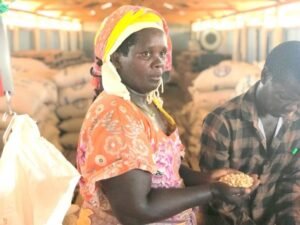By Marion Wagaki, Rootooba, 28 July 2020
More than 11 million people in Kenya, Ethiopia and Somalia are currently affected by the desert locust infestations; the Food and Agriculture Organization of the United Nations (FAO) report finds.
In addition to other agricultural production challenges such as COVID-19 pandemic disruption and floods, desert locust invasion continues to threaten food security. Surveillance and control measures have, however, remained steadfast.
In Kenya, a recent update on the locust situation from FAO shows that despite locust swarms having declined in the northwest, mainly in Marsabit County, they continue to be present in Turkana, where aerial and ground control operations are in progress.
However, the scale of the migration of remaining swarms from Kenya is likely to be smaller than previously anticipated due to ongoing control efforts. Since January, FAO has appealed for urgent funding to tackle the outbreak to protect livelihoods and food security. In response, the United Kingdom has contributed Ksh 2.34 billion (UK pounds 17 million) to support efforts to combat the ongoing desert locust surge in East Africa and its potentially devastating impacts.
The contribution made to FAO will go far in helping to safeguard food security and livelihoods of vulnerable farmers and their families.
In a press release today, FAO Director-General QU Dongyu said, “We are grateful to the United Kingdom for their consistent support to help families in Africa and Asia threatened by desert locusts.
The funds which have come via the United Kingdom’s Department for International Development (DFID) are in addition to a previous contribution of Ksh 1.1 billion (UK pound 8 million) donated earlier this year for the desert locust appeal.
FAO is augmenting governments and other partners’ capacities in affected countries with surveillance and coordination, technical advice, supplies and equipment.
The UN agency is also providing farmers with livelihood packages, assuring veterinary care and feed for vegetation-starved livestock, and assisting families who have lost their crops with cash and farming inputs, for them to put food on the table.
According to FAO, with just a 1 km square swarm able to consume the same amount of food in one day as 35 000 people, the pest poses an unprecedented threat to the immediate food security and longer-term resilience of millions of vulnerable farmers and pastoralists.
There is still a serious risk of swarms migrating from the Horn of Africa to West Africa, India and Pakistan speeded by heavy spring rains across East Africa leading to better breeding conditions for the most destructive migratory pest in the world. As noted by the FAO Desert Locust hub, the next generation swarms could be larger than the current ones.
“Although substantial gains have been made in the fight against the desert locust, sustained support is critical to contain the threat. Capacity to detect the desert locust early enough is crucial, including through the use of technologies and partnerships, and for that we must work together,” said Qu.
FAO’s latest desert locust appeal is for Ksh 33.6 billion (USD 311.6 million) to deal with the expansion of the upsurge, covering the Greater Horn of Africa, Yemen, West Africa, the Sahel and Southwest Asia.
So far, Ksh 19.65 billion (USD 182 million have been received or committed to the appeal, leaving a gap of Ksh 13.99 billion (USD 129.6 million).
FAO says that if the appeal is not fully funded, control efforts could slow or cease entirely by late September/October, leading to the numbers of the crop-devouring pest soaring again, further endangering millions of rural livelihoods.
“Vulnerable families need support, and to do so national capacities in monitoring and responding to desert locust must also be strengthened,” FAO says.
DFID also announced an additional Ksh 137.6 million (UK pound 1 million), which will be dedicated to supporting several institutions, including the University of Cambridge, to establish tools, technologies and partnerships needed for effective pest surveillance, forecasting and early warning activities.
In addition to the renewed support from the United Kingdom, contributions have also been received from Belgium, Canada, China, Denmark, France, Germany, Italy, the Netherlands, Norway, the Republic of Korea, the Russian Federation, Saudi Arabia, Sweden, Switzerland, the United Arab Emirates, the United States of America, the African Development Bank, the Africa Solidarity Trust Fund, the Bill and Melinda Gates Foundation, the UN Central Emergency Response Fund (CERF), the UN’s Office for the Coordination of Humanitarian Affairs (OCHA), the European Union, the Louis Dreyfus Foundation, the Mastercard Foundation and the World Bank Group.







